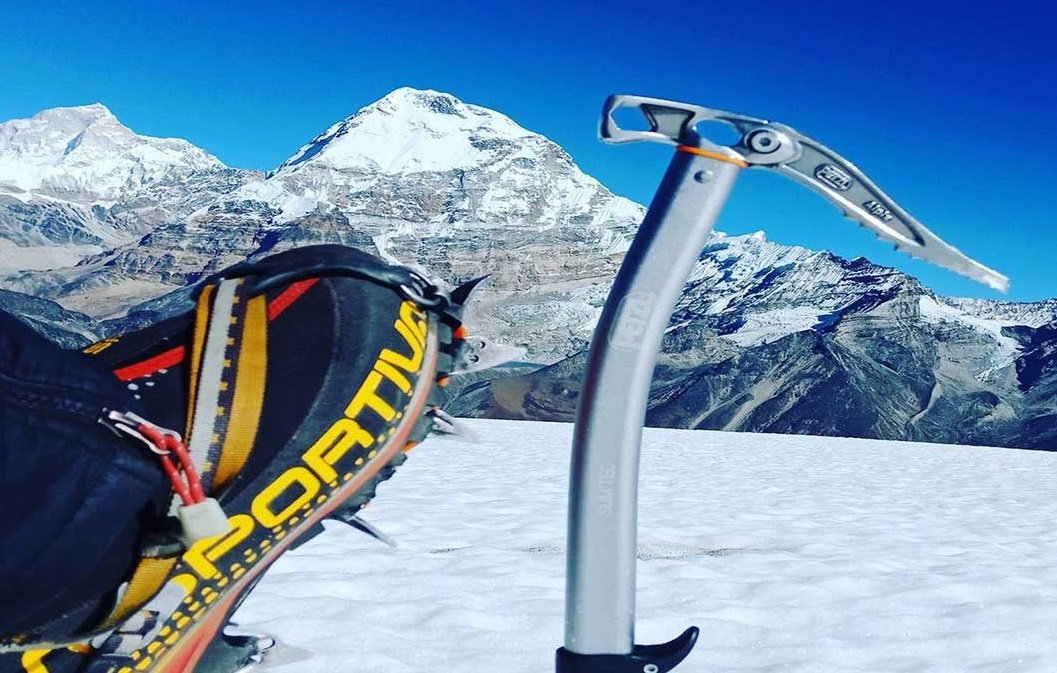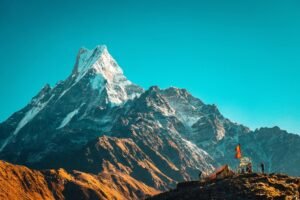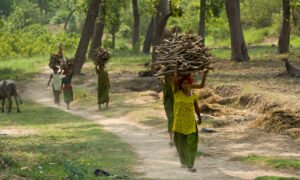Mountaineering in the Himalayas is a demanding and exhilarating endeavor that requires meticulous preparation and the right gear. Whether you’re aiming for the summit of Everest or exploring lesser-known peaks, having the proper equipment is crucial for safety and success. This comprehensive guide will walk you through the essential gear you’ll need for Himalayan mountaineering, ensuring you’re well-prepared for one of the most challenging and rewarding adventures of your life.
1. Clothing
The weather in the Himalayas can be extreme and unpredictable, necessitating a layering system that allows for versatility and adaptability. Here’s a detailed breakdown of the clothing you’ll need:
Base Layers:
Moisture-wicking base layers: These are critical for keeping your skin dry and preventing hypothermia. Look for synthetic materials or merino wool, which are excellent at wicking moisture away from the body. A good base layer set typically includes both a top and bottom.
Thermal tops and bottoms: In extremely cold conditions, thermal layers help retain body heat. These are worn over your base layers and provide additional insulation.
Insulating Layers:
Fleece jackets and pants: These provide a crucial mid-layer that traps heat. Fleece is lightweight, breathable, and retains its insulating properties even when wet.
Down or synthetic insulated jackets:These are essential for maintaining warmth in extremely cold conditions. Down jackets are favored for their superior warmth-to-weight ratio, but synthetic options are better suited for wet conditions as they retain warmth even when damp. It’s advisable to carry both lightweight and heavyweight options to layer as needed.
Shell Layers:
Waterproof and windproof jacket and pants: These outer layers protect you from wind, rain, and snow. They should be made from breathable materials like Gore-Tex to prevent moisture buildup inside your clothing. Look for jackets and pants with ventilation zippers to regulate body temperature.
Softshell jacket and pants: These are ideal for conditions where you need some protection from wind and light moisture but still require breathability and flexibility.
Other Clothing:
Gloves and mittens: A combination of lightweight liners, insulated gloves, and heavy mittens is essential. Liners can be worn alone in milder conditions, while heavier gloves and mittens are necessary for extreme cold and when handling ropes and tools.
Hats and balaclavas: These protect your head and face from the cold and wind. A balaclava can cover your entire face, leaving only your eyes exposed, which is vital in severe wind chills.
Gaiters:These are worn over your boots and lower legs to keep snow and debris out, which is especially important when trekking through deep snow or climbing in mixed conditions.
2. Footwear
Your feet are your primary means of transportation in the mountains, so investing in the right footwear is paramount.
Mountaineering boots: These should be sturdy, insulated, and compatible with crampons. Double-layered boots with removable liners are ideal for extreme cold as they allow you to dry the liners overnight.
Climbing shoes: For technical rock sections, specialized climbing shoes provide the necessary grip and sensitivity. However, these are usually only required for certain climbs.
Camp shoes: Lightweight, insulated footwear is useful for wearing around base camp and higher camps to give your feet a break from the heavy boots.
3. Climbing Gear
The right climbing gear can make the difference between a successful ascent and a dangerous situation. Here’s what you’ll need:
Harness: A comfortable, adjustable harness is essential for glacier travel and technical climbing. Ensure it fits well over multiple layers of clothing.
Helmet: A lightweight, durable helmet protects against falling rocks, ice, and accidental impacts. Make sure it’s well-ventilated for comfort.
Ice axe: Essential for self-arrest and general mountaineering. Choose a technical ice axe for steep ice sections.
Crampons: Ten or twelve-point crampons compatible with your boots are crucial for icy and snowy conditions. Having both general mountaineering and technical climbing crampons is advisable.
Carabiners: A mix of locking and non-locking carabiners is necessary for securing gear and setting up anchors. Look for lightweight options with high strength ratings.
Rope: Dynamic climbing rope is necessary for belaying and rappelling. Static rope may also be needed for setting up fixed lines.
Belay device: This is used for controlling the rope during belays and rappels. An ATC (Air Traffic Controller) or similar device is versatile and easy to use.
Slings and runners: These are used for setting up anchors and extending protection. Dyneema slings are lightweight and strong.
Ascenders and descenders: For fixed rope ascents and controlled descents, mechanical ascenders and descenders are invaluable.
Ice screws and pickets: These are used for creating secure anchors in ice and snow. Carry a variety of lengths and types to suit different conditions.
Pulley system: For crevasse rescue and hauling gear, a simple pulley system can be life-saving.
4. Camping Gear
Living in the harsh conditions of the Himalayas requires reliable and durable camping gear.
Tent: A four-season tent that can withstand high winds and heavy snow is essential. Look for models with robust poles and plenty of guy lines for securing the tent in strong winds. It’s wise to have both a base camp tent and a lighter, more compact high-altitude tent.
Sleeping bag: Choose a bag rated for extreme cold, typically filled with down for its superior insulation properties. A temperature rating of -20°C (-4°F) or lower is recommended for high-altitude expeditions.
Sleeping pad: An insulated pad not only provides comfort but also crucial thermal protection from the cold ground. Consider using a combination of foam and inflatable pads for maximum insulation.
Stove: A reliable, high-altitude stove is essential for melting snow and cooking. Models that run on liquid fuel tend to perform better in extreme cold compared to canister stoves.
Cookware: Lightweight pots, pans, and utensils should be sufficient for your cooking needs. Consider a heat-exchange system that improves fuel efficiency.
Hydration system: Insulated bottles and hydration bladders are necessary to prevent freezing. A water filter or purification tablets are essential for treating water from natural sources.
5. Navigation and Communication
Effective navigation and communication are vital for safety in the remote and challenging environment of the Himalayas.
GPS device: A GPS device is crucial for navigation in whiteouts and unfamiliar terrain. Ensure it’s rugged and has long battery life.
Maps and compass: These are reliable backups to electronic navigation tools. Learning how to use them effectively is essential.
Altimeter: To track elevation changes and monitor progress. Many watches now come with built-in altimeters.
Satellite phone or radio: For emergency communication, a satellite phone or a high-frequency radio is indispensable.
Personal locator beacon (PLB): This device signals distress and location to rescue teams in emergencies. Some modern PLBs also have messaging capabilities.
6. Personal Gear
Personal gear is crucial for comfort and safety during the expedition.
Backpack: A large-capacity pack (60-80 liters) for carrying gear to higher camps, and a smaller daypack (20-30 liters) for summit pushes. Look for packs with a good suspension system and weather-resistant materials.
Sunglasses and goggles: High-quality, UV-protective eyewear is essential to prevent snow blindness. Wraparound designs with side shields offer maximum protection.
Headlamp: A powerful headlamp with extra batteries is necessary for early starts and nighttime climbing. Models with adjustable brightness and red-light modes are particularly useful.
First aid kit:A comprehensive kit should include medications, bandages, blister care, and high-altitude medication like acetazolamide. Tailor the kit to the specific needs of your team and the nature of your expedition.
Sun protection:High-SPF sunscreen and lip balm are crucial to prevent sunburn at high altitudes. Consider formulations that are effective in extreme conditions.
Multitool or knife: A multitool with a variety of functions is useful for gear repairs and emergency situations.
Personal items: Lightweight toiletries, a camera for documenting your journey, a journal for recording experiences, and any other personal necessities.
7. Food and Nutrition
Proper nutrition is vital for maintaining energy levels and overall health during your expedition.
High-calorie, lightweight food: Freeze-dried meals, energy bars, nuts, and dried fruits are ideal. They offer high caloric density and are easy to prepare.
Electrolyte supplements: These help maintain electrolyte balance and prevent dehydration. Choose flavors and formats that you find palatable.
Energy gels and chews: Quick energy sources are useful for strenuous climbs. These are easy to consume and provide a rapid energy boost.
8. Miscellaneous Items
Additional items that can prove invaluable during your expedition include:
Repair kit: This should include materials for fixing gear and clothing in the field. Duct tape, sewing kit, and spare parts for your stove and tent are examples of what to include.
Trash bags: Essential for keeping the environment clean and for carrying out waste. Adhering to Leave No Trace principles is particularly important in fragile mountain environments.
Emergency shelter: A lightweight bivy sack or emergency blanket can be a lifesaver in unexpected situations.
Preparing for the Journey
Before embarking on a Himalayan mountaineering expedition, thorough preparation is essential. Here are some additional tips:
1.Training: Physical fitness is crucial. Train with a mix of cardio, strength, and endurance exercises. Practice with
the gear you’ll use, including climbing techniques and rescue drills. Simulate the weight of your pack and the types of terrain you’ll encounter.
2. Acclimatization: Proper acclimatization is critical to avoid altitude sickness. Plan for a gradual ascent and include rest days. Familiarize yourself with the symptoms of altitude sickness and know how to respond.
3.Research: Study the route, weather patterns, and local conditions. Familiarize yourself with the symptoms and treatment of altitude sickness. Keep abreast of any advisories or changes in regulations.
4. Permits and Regulations: Ensure you have all necessary permits and are aware of local regulations. Respect local customs and the environment. Engage with local communities and understand their perspectives on mountaineering activities.
5. Team and Support: Consider the support of a reputable guiding company, especially if you’re new to high-altitude mountaineering. Experienced guides can provide invaluable assistance, from technical guidance to logistical support.
Himalayan mountaineering is a challenging yet incredibly rewarding pursuit. Equipping yourself with the right gear and preparing thoroughly can make the difference between a successful summit and a dangerous ordeal. Always prioritize safety, and remember that the journey itself is as significant as reaching the summit. With the right preparation, you can experience the unparalleled beauty and adventure of the Himalayas. Happy climbing!





